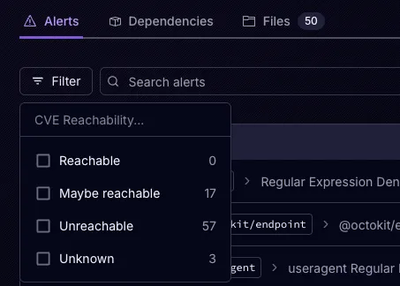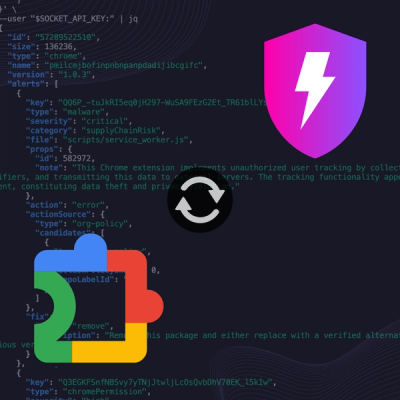
Product
Announcing Precomputed Reachability Analysis in Socket
Socket’s precomputed reachability slashes false positives by flagging up to 80% of vulnerabilities as irrelevant, with no setup and instant results.
Wayward is a Python package that helps to identify characteristic terms from single documents or groups of documents.
.. image:: https://readthedocs.org/projects/wayward/badge/?version=latest :target: https://wayward.readthedocs.io/en/latest/?badge=latest :alt: Documentation status
.. image:: https://badge.fury.io/py/wayward.svg :target: https://pypi.org/project/wayward/ :alt: PyPI package version
.. docs-inclusion-marker
Wayward is a Python package that helps to identify characteristic terms from single documents or groups of documents. It can be used for keyword extraction and several related tasks, and can create efficient sparse representations for classifiers. It was originally created to provide term weights for word clouds.
Rather than use simple term frequency to estimate the importance of words and phrases, it weighs terms by statistical models known as parsimonious language models. These models are good at picking up the terms that distinguish a text document from other documents in a collection.
For this to work, a preferably large amount of documents is needed to serve as a background collection, to compare the documents of interest to. This could be a random sample of newspaper articles, for instance, but for many applications it works better to take a natural collection, such as a periodical publication, and to fit the model for separate parts (e.g. individual issues, or yearly groups of issues).
See the References_ section for more information about parsimonious
language models and their applications.
Wayward does not do visualization of word clouds. For that, you can paste
its output into a tool like http://wordle.net or the IBM Word-Cloud Generator <http://www.alphaworks.ibm.com/tech/wordcloud>_.
Either install the latest release from PyPI::
$ pip install wayward
or clone the git repository, and use Poetry <https://poetry.eustace.io/docs/>_
to install the package in editable mode::
$ git clone https://github.com/aolieman/wayward.git
$ cd wayward/
$ poetry install
quotes = [ ... "Love all, trust a few, Do wrong to none", ... ... ... "A lover's eyes will gaze an eagle blind. " ... "A lover's ear will hear the lowest sound.", ... ] doc_tokens = [ ... re.sub(r"[.,:;!?"‘’]|'s\b", " ", quote).lower().split() ... for quote in quotes ... ]
The ParsimoniousLM is initialized with all document tokens as a
background corpus, and subsequently takes a single document's tokens
as input. Its top() method returns the top terms and their probabilities:
from wayward import ParsimoniousLM plm = ParsimoniousLM(doc_tokens, w=.1) plm.top(10, doc_tokens[-1]) [('lover', 0.1538461408077277), ('will', 0.1538461408077277), ('eyes', 0.0769230704038643), ('gaze', 0.0769230704038643), ('an', 0.0769230704038643), ('eagle', 0.0769230704038643), ('blind', 0.0769230704038643), ('ear', 0.0769230704038643), ('hear', 0.0769230704038643), ('lowest', 0.0769230704038643)]
The SignificantWordsLM is similarly initialized with a background corpus,
but subsequently takes a group of document tokens as input. Its group_top
method returns the top terms and their probabilities:
from wayward import SignificantWordsLM swlm = SignificantWordsLM(doc_tokens, lambdas=(.7, .1, .2)) swlm.group_top(10, doc_tokens[-2:], fix_lambdas=True) [('much', 0.09077675276900632), ('lover', 0.06298706244865138), ('will', 0.06298706244865138), ('you', 0.04538837638450315), ('your', 0.04538837638450315), ('rhymes', 0.04538837638450315), ('speak', 0.04538837638450315), ('neither', 0.04538837638450315), ('rhyme', 0.04538837638450315), ('nor', 0.04538837638450315)]
See |example/dickens.py|_ for a runnable example with more realistic data.
.. |example/dickens.py| replace:: example/dickens.py
.. _example/dickens.py: https://github.com/aolieman/wayward/blob/master/example/dickens.py
This package started out as WeighWords_, written by Lars Buitinck at the University of Amsterdam. It provides an efficient parsimonious LM implementation, and a very accessible API.
A recent innovation in language modeling, Significant Words Language Models, led to the addition of a two-way parsimonious language model to this package. This new version targets python 3.x, and after a long slumber deserved a fresh name. The name "Wayward" was chosen because it is a near-homophone of WeighWords, and as a nod to parsimonious language modeling: it uncovers which terms "depart" most from the background collection. The parsimonization algorithm discounts terms that are already well explained by the background model, until the most wayward terms come out on top.
See the Changelog_ for an overview of the most important changes.
.. _WeighWords: https://github.com/larsmans/weighwords/ .. _Changelog: https://wayward.readthedocs.io/en/develop/changelog.html
D. Hiemstra, S. Robertson, and H. Zaragoza (2004). Parsimonious Language Models for Information Retrieval <http://citeseer.ist.psu.edu/viewdoc/summary?doi=10.1.1.4.5806>_.
Proc. SIGIR'04.
R. Kaptein, D. Hiemstra, and J. Kamps (2010). How different are Language Models and word clouds? <http://citeseer.ist.psu.edu/viewdoc/summary?doi=10.1.1.189.822>_.
Proc. ECIR'10.
M. Dehghani, H. Azarbonyad, J. Kamps, D. Hiemstra, and M. Marx (2016).
Luhn Revisited: Significant Words Language Models <https://djoerdhiemstra.com/wp-content/uploads/cikm2016.pdf>_.
Proc. CKIM'16.
FAQs
Wayward is a Python package that helps to identify characteristic terms from single documents or groups of documents.
We found that wayward demonstrated a healthy version release cadence and project activity because the last version was released less than a year ago. It has 1 open source maintainer collaborating on the project.
Did you know?

Socket for GitHub automatically highlights issues in each pull request and monitors the health of all your open source dependencies. Discover the contents of your packages and block harmful activity before you install or update your dependencies.

Product
Socket’s precomputed reachability slashes false positives by flagging up to 80% of vulnerabilities as irrelevant, with no setup and instant results.

Product
Socket is launching experimental protection for Chrome extensions, scanning for malware and risky permissions to prevent silent supply chain attacks.

Product
Add secure dependency scanning to Claude Desktop with Socket MCP, a one-click extension that keeps your coding conversations safe from malicious packages.